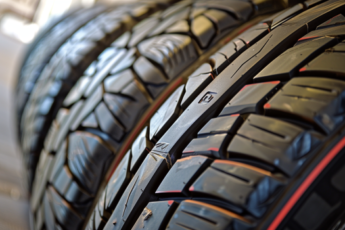Last Updated on 7 days
Understanding the Right Time for a New Tires
Understanding the lifespan of your tires is an essential aspect of vehicle maintenance. It ensures the safety of your journeys and the efficiency and performance of your vehicle. Tires are the critical point of contact between your car and the road, and their condition can significantly impact how your vehicle handles various driving conditions.
This introduction to tire life will guide you through the fundamentals of tire longevity, from recognizing signs of wear to understanding the factors influencing how long your tires last. With this knowledge, you can make informed decisions about tire maintenance and replacements, ultimately contributing to a safer and more enjoyable driving experience.

Significance of Tire Durability
Tire durability is a cornerstone of responsible vehicle ownership. It directly impacts a vehicle’s safety performance, operational efficiency, and cost-effectiveness.
Several factors influence tire lifespan, including material composition, design features, driving habits, and adherence to proper maintenance schedules. Durable tires are paramount for a safe driving experience. They ensure optimal traction, handling, and vehicle stability, all contributing to effective braking and improved fuel economy.
From a financial perspective, tires represent a significant investment. Durable tires offer an extended service life, reducing replacement frequency and generating long-term cost savings. Furthermore, proper tire maintenance fosters environmental sustainability by minimizing tire waste and lowering the demand for raw materials and production energy.
Understanding the importance of tire durability is crucial for all vehicle owners. It directly affects their safety on the road, personal budget, and the environmental impact of their driving practices.
Purpose of This Guide New Tires
This guide serves as a comprehensive resource for vehicle owners, particularly those unfamiliar with tire technical aspects. It delves into maximizing tire lifespan and identifying the opportune moments for tire replacements.
The core objective is to empower vehicle owners with knowledge. This guide aims to facilitate an understanding of the intricacies of tire maintenance and replacement. Doing so equips owners to make informed decisions that prioritize safety, optimize vehicle performance, and contribute to environmental sustainability.
New Tires Fundamentals
Understanding the basics of tire construction and the types of tires available for various vehicles is crucial for making informed decisions about tire maintenance and replacement.
Anatomy of a New Tires
The anatomy of a tire is more complex than it might appear at first glance. A typical tire consists of several components, each serving a specific function:
- Tread: The outermost layer, the tread, provides traction and determines the tire’s grip on the road surface. Tread patterns vary depending on the tire’s intended use.
- Sipes: These tiny grooves in the tread improve traction, especially in wet conditions.
- Belt: Located beneath the tread, steel belts reinforce the tire structure and provide stability.
- Sidewall: This part of the tire offers lateral stability and protection. The sidewall contains essential information about the tire, including size, type, and performance ratings.
- Bead: The bead ensures the tire remains securely fitted to the rim. It’s made of solid and durable materials like steel and rubber.
- Inner Liner: This is the innermost layer of the tire, holding the compressed air in tubeless tires.
- Carcass Ply: This layer gives the tire its shape and strength. It is typically made of layers of fabric or steel cords.
Each component is critical to the tire’s performance, durability, and safety.
Varieties of Tires for Different Vehicles
Tires are not one-size-fits-all components. Different types of vehicles and driving conditions require specific types of tires:
- Passenger Car Tires: Designed for everyday vehicles, these tires prioritize comfort, fuel efficiency, and all-around performance.
- Truck and SUV Tires: These are built to handle heavier loads and may offer off-road capabilities. They are often more robust than passenger car tires.
- Performance Tires: Focused on superior handling and speed capabilities, performance tires are suitable for sports cars and high-performance vehicles.
- All-Season Tires: Ideal for weather conditions, balancing wet and dry performance, and snow traction.
- Winter Tires: Specifically designed for cold weather and snow, these tires have unique tread designs and rubber compounds for better grip in winter conditions.
- Off-Road Tires: Built for rough terrain, these tires have aggressive tread patterns and are constructed to withstand harsh conditions.
- Eco-Friendly Tires: These are designed to reduce fuel consumption and emissions and are often made with unique materials and technologies.
- Run-Flat Tires: These tires can maintain functionality for a limited distance even after a puncture, allowing drivers to reach a safe location for repair.
The selection of appropriate tires is a critical aspect of vehicle ownership that directly impacts safety and longevity. Due to the inherent variations in tire design and composition, each type offers distinct features and capabilities. A fundamental understanding of these diversities is paramount for ensuring optimal tire health and, more importantly, the vehicle’s and its occupants’ safety. By aligning tire selection with the demands of their driving environment and habits, owners can maximize performance and promote the safe operation of their cars.
Determinants of Tire Life
Tire longevity is influenced by several key factors that interact with the tire throughout its lifecycle. Understanding these determinants can help vehicle owners prolong the life of their tires, ensuring safety and efficiency on the road.

Effect of Terrain and Road Surfaces
The type of terrain and road surfaces a vehicle frequently encounters significantly affects tire wear and longevity. Different surfaces exert varying degrees of stress and abrasion on tires:
- Smooth Pavement: Provides the least resistance and wear, ideal for tire longevity.
- Rough Roads: Gravel, uneven pavement, and potholes can cause quicker wear, stress, and potential damage to tires.
- Off-Road Conditions: Driving on surfaces like mud, sand, or rocky terrain can lead to aggressive wear and tear due to increased friction and obstacles.
- Urban vs. Rural Driving: City driving often involves more stops and starts, leading to faster tread wear, while rural or highway driving may result in more even wear over time.
Regularly encountering harsh road conditions necessitates more frequent tire inspections and potential replacements.
Load and Weight Distribution on New Tires
The weight a vehicle carries and how it is distributed significantly affects tire life:
- Vehicle Load: Overloading a vehicle puts extra pressure on the tires, leading to increased wear and potential damage.
- Uneven Weight Distribution: Unequal load distribution can cause uneven tire wear. Regularly rotating tires can help mitigate this issue.
- Towing and Hauling: Vehicles that frequently tow or haul heavy loads experience additional stress on tires, requiring more robust or specialized tires.
Maintaining appropriate load levels and regular tire rotations are crucial for prolonging tire life under varying weight conditions.
Driving Patterns and Tire Durability
The way a vehicle is driven can have a significant impact on tire longevity:
- Aggressive Driving: Habits like rapid acceleration, hard braking, and sharp turns increase tire wear.
- Speed: Higher speeds generate more heat and friction, accelerating tire wear.
- Consistent Route Conditions: Regular driving on specific types of roads can lead to predictable wear patterns, which can be managed through maintenance practices.
Adopting a smoother driving style can significantly extend tire life.
Climate and Weather Influences
Weather conditions and climate also play a crucial role in tire wear:
- Temperature Fluctuations: Extreme temperatures, both hot and cold, can affect tire pressure and elasticity, leading to increased wear or potential damage.
- Wet Conditions: Rainy or snowy conditions can lead to hydroplaning risks and affect tire tread wear differently than dry conditions.
- UV Exposure: Prolonged exposure to sunlight and UV radiation can cause tires to age prematurely, leading to cracking and degradation of rubber compounds.
Choosing tires suitable for the local climate and regularly checking and adjusting tire pressure can help mitigate these effects.
Understanding the various factors that affect tire life is essential for vehicle owners. By considering the impacts of terrain and road surfaces, load and weight distribution, driving patterns, and climate and weather influences, drivers can take proactive steps to maximize tire longevity. This comprehensive approach to tire care, as Giga Tires advocates, not only ensures optimal performance and safety but also contributes to cost savings and environmental sustainability.
Identifying new Tire Degradation
Tire health plays an essential role in the overarching theme of vehicular safety and performance. Tires, after all, serve as the sole point of contact between a vehicle and the road surface. Consequently, their condition is of paramount importance. This section of Giga Tires’ comprehensive guide delves into identifying tire wear patterns and their associated implications.
Physical Signs of Tire Deterioration
Explore the visible tire wear indicators, learning to identify physical signs of tire deterioration. This introduction guides you through the key aspects to look for, ensuring timely maintenance and replacement for optimal safety.
- Tread Wear: As the most evident sign of tire degradation, tread depth diminishes over time. Tires incorporate tread wear indicators and small raised sections within the tread grooves. Tire replacement is imperative once these indicators level with the surrounding tread surface.
- Sidewall Damage: Cracks or cuts on the tire sidewall can signify either aging or impact-induced damage. Such compromises can lead to air leaks or, in extreme cases, catastrophic blowouts. A thorough inspection of the sidewall for any signs of damage is essential.
- Bulges and Blisters: Deformations on the tire surface, manifesting as bulges or blisters, indicate internal weaknesses. These weaknesses can lead to sudden and potentially dangerous tire failure. Any bulges or blisters necessitate immediate professional inspection and likely tire replacement.
- Vibration and Unusual Noises: Vibrations or noises emanating from the vehicle during operation, exceeding what one might expect from typical road conditions or suspension characteristics, can point to tire problems. Unusual vibrations or noises warrant prompt inspection to identify the underlying cause.
- Uneven Tread Wear: Tread wear that is not uniform across the tire surface signifies potential issues beyond normal wear and tear. Uneven wear patterns can be caused by improper inflation, misalignment of the wheels, or problems with the vehicle’s suspension system. A professional inspection is recommended to diagnose the cause and implement corrective measures.
Regularly inspecting tires for these physical signs can help identify when tires are nearing the end of their lifespan.
Performance Red Flags for Tire Change
Delve into the performance indicators that signal the need for a tire change. Understanding these red flags can enhance road safety, vehicle handling, and overall driving experience.
- Decreased Traction: If tires lose grip in wet conditions or take longer to stop, this could be a sign of worn tread.
- Handling Difficulties: Difficulty with steering or maintaining vehicle control, especially in corners, can indicate tire issues.
- Changes in Fuel Efficiency: Deteriorating tires can reduce fuel efficiency. Tire condition should be checked if a sudden drop in miles per gallon is noticed.
- Increased Road Noise: Excessive noise from tires during driving can indicate uneven tread wear or internal damage.
Monitoring these performance indicators can provide early warnings of tire degradation.
Risks Associated with Overused Tires
The decision to replace tires should not be taken lightly. Operating a vehicle on overused tires presents many risks and potential hazards, jeopardizing safety and integrity. This section highlights the importance of timely tire replacement to avoid accidents and maintain vehicle integrity.
- Blowouts: Worn or damaged tires are more susceptible to blowouts, which can be dangerous, especially at high speeds.
- Hydroplaning: Worn tires with low tread depth are less effective at channeling water away, increasing the risk of hydroplaning in wet conditions.
- Reduced Braking Efficiency: Worn tires can significantly impact braking distance, especially on wet or slippery surfaces.
- Poor Handling: Compromised tire integrity can lead to poor vehicle handling, making it challenging to control the vehicle during emergency maneuvers.
- Accidents: Ultimately, the risks associated with overused tires can increase the chances of accidents due to the above factors.
Regular inspection for physical signs of deterioration, monitoring performance red flags, and understanding the risks associated with overused tires are essential for vehicle safety. This guide from Giga Tires aims to empower vehicle owners with the knowledge to identify tire degradation proactively, ensuring timely tire replacement and maintenance for optimal vehicle performance and safety.
6 Tips To Maximize Tire Life
Maximizing the lifespan of your tires is both an art and a science. Here are six friendly yet technically informed tips to keep your tires rolling longer and your drives smoother:
- Regular Tire Pressure Checks: Think of tire pressure as the heartbeat of your tires. It is vital for optimal performance and longevity. Keeping them properly inflated ensures better gas mileage and smoother rides. Grab a tire pressure gauge and some air, and make it a routine check. Remember, the best time to check is when the tires are cold – ideally after the car has been idle for a few hours or driven less than a mile at a moderate speed. Unsure about the ideal pressure? Peek at your car’s driver’s side door sticker or check the owner’s manual.
- Keeping Wheels Aligned: Similar to how good posture benefits the human body, proper tire alignment is essential for optimal vehicle health. When aligned correctly, tires contact the road surface at the designated angles and remain parallel. Conversely, misaligned tires can experience uneven or premature wear.
- Tire Rotation Rituals: Each tire on your car carries a different burden, especially in vehicles where only two wheels do most of the driving. To prevent uneven wear, rotate them regularly, following your vehicle manufacturer’s recommendation, or every 5,000 miles.
- Balancing Act: The sensation of a shaking steering wheel or vibration throughout the vehicle during highway travel can be a telltale sign of imbalanced tires. Over time, the weights meticulously positioned by a technician during the tire balancing process can shift or become dislodged.
- Monitor Tire Tread: Tread depth is critical for safe driving, mainly to prevent skidding and sliding. Once they are worn down to 2/32 of an inch, they are officially unsafe. However, for an extra margin of safety, consider replacing them at 4/32 of an inch, as suggested by Consumer Reports. Keep an eye on the tread wear indicators – when the tread levels are high with these, it’s shopping time!
- Seasonal Switch-Ups: Tire selection should adapt to climatic conditions. Transitioning from winter tires formulated for low temperatures and snow traction to all-season or summer tires during warmer months optimizes performance and tread life. This seasonal swap ensures both safety and cost-effectiveness for drivers.
Tires are more than just rubber circles; they’re the foundation of your vehicle’s safety and efficiency. Treat them well, and they will do the same for you! Happy driving!
Maintenance Strategies for Tire Longevity
Effective maintenance is key to extending tire life and ensuring vehicle safety. This section, part of Giga Tires’ comprehensive guide, delves into essential practices for tire upkeep.
Routine Tire Checks and Care
Regular tire inspections are crucial for identifying potential issues before they become significant problems.
- Tread Depth Inspection: Check tread depth to ensure it’s above the legally required minimum (usually 2/32 of an inch). Tread wear indicators, built into most tires, help in assessing this.
- Visual Inspection: Look for signs of damage, such as cuts, cracks, bulges, or objects embedded in the tires.
- Tire Rotation: Regular rotation, typically every 5,000 to 8,000 miles, ensures even wear and prolongs tire life. This involves changing the position of each tire on the vehicle.
- Alignment Checks: Poor alignment can cause uneven tire wear. Correct the alignment, especially after hitting a significant pothole or curb.
- Balancing: Ensuring balanced tires prevent vibration, reduce wear, and extend tire life.
These routine checks and care extend tire life and enhance safety and performance.
Importance of Air Pressure Management
Proper tire inflation is one of the most important aspects of tire maintenance.
- Regular Pressure Checks: To ensure optimal tire performance and safety, tire pressure should be checked monthly and before undertaking extended journeys. The manufacturer’s recommended inflation pressures can be found in the vehicle’s owner’s manual or on the driver’s door jamb sticker.
- Effects of Incorrect Pressure: Underinflated tires lead to increased wear and tear, reduced fuel efficiency, and overheating, potentially causing blowouts. Overinflation leads to reduced traction and uneven wear.
- Seasonal Adjustments: Tire pressure varies with temperature changes, necessitating more frequent checks and adjustments in extreme weather conditions.
Maintaining the correct tire pressure is a simple yet effective way to extend tire life and improve vehicle safety.
Addressing Tire Damage Proactively
Proactive responses to tire damage can prevent further deterioration and ensure safety.
- Prompt Repairs: Address minor punctures or cuts swiftly to prevent further damage and potential replacement.
- Professional Expertise: For severe damage, such as deep cuts or bulges, seek a tire professional’s assessment to ensure safety and determine the appropriate action.
- Hazard Awareness: Exercise caution around road hazards like potholes, debris, and curbs to minimize tire damage.
- Quality Matters: Ensure repairs are performed by qualified professionals using appropriate methods and materials to safeguard tire integrity.
Proactively managing tire damage is essential to maintaining tire health and extending lifespan.
Selecting Replacement Tires
Choosing the right replacement tires is a critical decision that affects a vehicle’s safety, performance, and efficiency. This segment of the comprehensive guide from Giga Tires focuses on the essential considerations in selecting replacement tires.
Understanding Tire Specifications
This introduction offers insights into the world of tire specifications, showing the various markings and tire ratings. Learn how to decipher these details to make informed decisions about the right tires for your vehicle.
- Tire Size: The size of a tire, indicated by a series of numbers and letters on the sidewall, is crucial for fitting and vehicle performance. This includes the width, aspect ratio, and diameter.
- Load Index: This number represents the maximum load the tire can support when properly inflated.
- Speed Rating: The speed rating indicates the tire’s maximum capability under specific service conditions.
- Treadwear, Traction, and Temperature Ratings: These ratings provide information on the tire’s expected wear, ability to stop on wet surfaces, and heat resistance.
- Type of Tire: This refers to whether the tire is all-season, performance, winter, or designed for specific uses like off-roading.
Understanding these specifications helps you choose tires that match the vehicle’s requirements and the driver’s expectations.
Tailoring Tire Choice to Vehicle and Usage
The optimal tire choice goes beyond a universal fit. This section explores the importance of aligning tire selection with specific vehicle types and usage patterns. By understanding the demands of your driving habits and the capabilities of your vehicle, you can ensure a tailored tire selection that prioritizes both performance and safety.
- Vehicle Type Compatibility: Ensure the tire is suitable for the type of vehicle, whether it is a passenger car, SUV, truck, or performance vehicle.
- Driving Conditions: Consider the typical driving conditions – city, highway, off-road, or varied weather conditions – and select tires designed to perform well in those environments.
- Special Needs: If the vehicle has any specific needs, like towing capacity or off-road capability, choose tires that enhance these aspects.
- Original Equipment (OE) Specifications: Sometimes, sticking to the tire specifications recommended by the vehicle manufacturer (OE specifications) is the best choice, especially if the vehicle’s performance is satisfactory.
Tailoring the tire choice to the vehicle’s specific needs and the usual driving conditions ensures optimal performance and safety.
Considering Price versus Performance
Delve into the often challenging decision of balancing price and performance when choosing tires. This introduction helps you navigate the trade-offs and guides you to select the best tires that meet your budget and performance requirements.
- Budget: Determine a budget, but remember that the cheapest option may only sometimes be the best in terms of quality and longevity.
- Long-Term Value: Consider the tires’ long-term value, including durability and the potential to improve fuel efficiency.
- Warranty and Guarantees: Look for warranties or guarantees that provide additional value and assurance of quality.
- Reviews and Ratings: Research reviews and ratings from other consumers and independent testing organizations to gauge performance and reliability.
Balancing the cost against the tires’ performance, safety features, and longevity ensures a wise investment. This guide from Giga Tires aims to give vehicle owners the knowledge to make informed decisions, ensuring their safety and satisfaction with their tire purchase.

Legal Compliance and Safety
Ensuring legal compliance and adhering to safety standards is a matter of following the law and committing to safety and responsibility. This section of the comprehensive guide from Giga Tires focuses on the importance of understanding and complying with tire regulations and safety standards.
Adhering to Tire Regulations
Tire regulations are critical in safeguarding drivers and promoting overall road safety. This section delves into the essential knowledge surrounding these regulations, highlighting the importance of adherence. By ensuring tires meet the established legal and safety standards, we contribute to a safer driving environment for everyone.
- Tire Regulations Overview: Tire regulations often vary by country and region, but generally, they include standards for tire manufacturing, performance, and wear limits. These regulations are designed to ensure that tires meet safety and environmental standards.
- Tread Depth Regulations: One of the most common regulations is the minimum tread depth. In many places, the legal minimum tread depth is 2/32 of an inch. Driving with tires below this limit can result in fines and is a safety hazard.
- Tire Labeling and Information: Tires must be appropriately labeled with information including size, type, load-carrying capacity, and speed rating. This information helps consumers select the appropriate tires for their vehicle and driving conditions.
- Compliance with Regional Laws: Some regions have specific winter tires or snow chain requirements. Drivers must know and comply with these regulations, especially when driving in different areas or countries.
Adhering to tire regulations is crucial to vehicle maintenance and ensures drivers use safe and appropriate vehicle tires.
Safety Standards for Tires
Explore the critical safety standards for tires, highlighting their significance in ensuring optimal tire performance and vehicle safety. This section educates drivers on the importance of choosing tires that conform to these established safety criteria.
- Importance of Safety Standards: Safety standards for tires are established to protect drivers, passengers, and pedestrians. These standards cover tire strength, durability, and performance in various conditions.
- Regular Safety Inspections: Vehicle owners should regularly inspect their tires for signs of wear, damage, or aging. Regular safety inspections can identify potential issues before they become serious problems.
- Manufacturer Compliance: Tire manufacturers must comply with various safety standards in the design and production of tires. This includes rigorous testing for durability, performance under stress, and hazard resistance.
- Understanding Ratings and Grades: Tires are often graded on treadwear, traction, and temperature resistance factors. Understanding these ratings helps consumers choose tires that provide the best safety and performance for their specific needs.
- Impact on Insurance and Liability: Using tires that meet safety standards can also affect vehicle insurance policies and liability in the event of an accident. Compliance with safety standards is often a requirement of insurance policies.
Adhering to tire regulations and safety standards is essential to responsible vehicle ownership. It ensures compliance with the law and significantly contributes to the safety of vehicle occupants and other road users. This guide from Giga Tires underscores the importance of understanding and observing these legal and safety requirements, reinforcing the commitment to safe and responsible driving.
Environmental Aspects of Tire Disposal
Used tires pose a significant environmental challenge due to their sheer volume and slow decomposition rates. Giga Tires’ guide addresses responsible end-of-life tire management, emphasizing eco-friendly disposal practices and tire recycling opportunities. By understanding these options, we can collectively promote a more sustainable approach to tire disposal.
Eco-Friendly Disposal Practices
Dive into the environmentally responsible practices for tire disposal, highlighting the importance of eco-friendly methods in reducing waste and protecting the environment. This introduction sheds light on the significance of sustainable disposal solutions for end-of-life tires.
- Proper Disposal at Certified Facilities: One of the primary methods of eco-friendly tire disposal is to ensure they are sent to certified disposal facilities. These facilities follow regulations that minimize the environmental impact, preventing tires from ending up in landfills where they can take hundreds of years to decompose.
- Avoiding Illegal Dumping: Illegal dumping of tires harms the environment and can lead to penalties and fines. It contributes to pollution and can cause public health issues, as tires can collect water and become breeding grounds for mosquitoes and other pests.
- Participation in Tire Take-Back Programs: Many tire retailers and manufacturers offer take-back programs where old tires can be returned for proper disposal or recycling. These programs are an easy and responsible way to dispose of old tires.
Opportunities for Tire Recycling
Explore the innovative and beneficial opportunities in tire recycling, where used tires are transformed into valuable resources. This section emphasizes the potential of recycling to contribute to environmental sustainability and the circular economy.
- Rubber Mulch for Landscaping: Recycled tires can be processed into rubber mulch used in landscaping and playgrounds. It is a durable, weather-resistant, and eco-friendly alternative to wood mulch.
- Civil Engineering Applications: Crumb rubber from recycled tires is used in various construction materials, such as asphalt for road construction, improving durability and reducing noise.
- Manufacturing of New Products: Recycled tire rubber is used to produce various products, including mats, footwear, and automotive parts. This reduces waste and decreases the demand for new raw materials.
- Energy Recovery: In some regions, tires are used as a source of energy in cement kilns or power plants. While this process does involve burning, it is done under controlled conditions, reducing the environmental impact compared to open burning.
- Innovative Recycling Projects: Continuous research and innovation lead to new ways to recycle tires, including recovering raw materials like steel and textile fibers.
The environmental aspects of tire disposal are a significant concern, but the impact can be mitigated through eco-friendly disposal practices and recycling opportunities. Giga Tires’ guide highlights the importance of responsible tire disposal and how old tires can be repurposed, contributing to environmental sustainability and resource conservation. This approach helps reduce waste and promotes the development of a circular economy in the tire industry.
Conclusion & Recommendations
This comprehensive guide explored essential tire maintenance, selection, and disposal aspects. Key takeaways include understanding the importance of tire durability for safety and efficiency, recognizing signs of tire degradation, and selecting appropriate replacements. Emphasis is placed on routine tire checks, proper air pressure management, and prompt attention to tire damage. The guide also highlights legal compliance, safety standards, and environmentally responsible tire disposal. Maintaining tire longevity is not just about selecting the right tire but also about regular upkeep. It is essential to conduct routine inspections for any signs of wear or damage, maintain correct tire pressure, and address any issues promptly to avoid further complications. Balancing and rotating tires regularly can also help in achieving even wear. Being mindful of your driving habits, such as avoiding aggressive driving and considering the load and weight distribution on your vehicle, will also contribute to the extended life of your tires.
Why Giga Tires
As we conclude this guide, it becomes evident that tire care is a multifaceted process requiring attention to detail, knowledge, and proactive maintenance. Whether you are looking for new tires, seeking advice on tire maintenance, or exploring eco-friendly disposal options, Giga Tires offers a comprehensive solution to all your tire-related needs.
At Giga Tires, we understand the importance of quality, safety, and value. Our extensive selection of tires caters to a wide range of vehicles and driving conditions, ensuring that you find the perfect match for your specific requirements. With our user-friendly website, finding the right tires is simple and convenient.
Explore Giga Tires’ Selection and Buy Now new tires
Explore Giga Tires’ extensive tire collection and benefit from our expert knowledge. We ensure a seamless experience, from tire selection to installation, for a safe, efficient, and enjoyable journey. Visit our website to browse and make your purchase today.
FAQs
At what point should you buy new tires?
Consider buying new tires when the tread wear indicators are flush with the tire’s tread, if there is a consistent loss of tire pressure, or if the tire fails the “penny test” (when a penny is inserted into the tread with Lincoln’s head down, and it does not reach his head).
How can I maximize the life of my new tires?
Regularly check and adjust tire pressure, rotate tires every 5,000 to 8,000 miles, maintain wheel alignment, and avoid harsh driving habits like sudden braking and fast turns.
What is the average life of a new tires?
The average tire life is between 25,000 and 50,000 miles, but this can vary based on driving habits, tire type, and maintenance practices.
How can you increase the life expectancy of tires?
Maintaining correct tire pressure, performing regular tire rotations, ensuring proper wheel alignment, and driving gently to reduce wear will increase tire life expectancy.
How will you ensure the long life of the tires?
Ensure long tire life by regularly checking for wear and damage, keeping tires properly inflated, balancing and rotating tires as per the schedule, and driving in a tire-friendly manner.
How can I improve my tire lifespan?
Regularly check and maintain the proper tire pressure, rotate your tires every 5,000 to 8,000 miles, and ensure your wheels are correctly aligned. Avoiding harsh driving habits like rapid acceleration and hard braking also helps.
How can I increase the life of my tires?
Keep your tires properly inflated to the recommended pressure, perform routine rotations to promote even wear, and consistently check for and address any signs of damage or wear.
How do I get more life out of my tires?
To extend tire life, maintain correct air pressure, regularly check for tread wear and damage, adhere to a tire rotation schedule, and drive smoothly to reduce tire stress.
How can I make my old tires last longer?
Properly inflate old tires, regularly inspect them for wear and damage, and drive cautiously to minimize excessive wear and tear.










